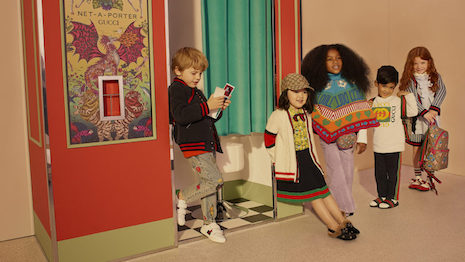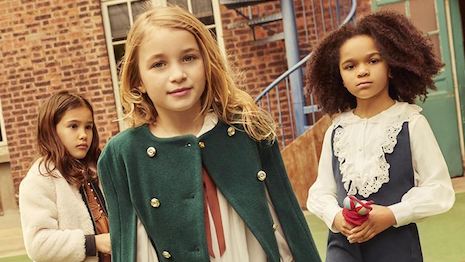 Knowledge of consumer and childhood behavior is important for luxury brands. Image credit: Yoox Net-A-Porter Group
Knowledge of consumer and childhood behavior is important for luxury brands. Image credit: Yoox Net-A-Porter Group
Exclusivity is a pillar of luxury, and new research suggests that people as young as 6 can show a preference for scarce over abundant goods.
Researchers from the Warwick Business School believe that scarcity preference is a trait that humans develop over time. Psychology and marketing research has previously shown that adults display a scarcity preference, which benefits luxury companies that limit product availability.
“Scarcity preferences seem to be uniquely human, and something we acquire during early childhood,” said Daniel Read, professor of behavioral science at Warwick Business School, Coventry, U.K. “But they are there, and even in a very transparent setting in which scarcity is clearly not due to the fundamental quality of the good, it still matters.
“People want scarce things,” he said.
Reward preferences
To examine the origins of scarcity preference, researchers created an experiment that tested whether chimpanzees, human’s closest living relatives, and young children preferred scarce or abundant goods.
The experiments were developed so the only quality distinguishing the items presented to the children and chimpanzees was the quantity. Participants were able to choose from a pile of identically wrapped items – non-scarce – or a single wrapped item – scarce.
 Baby Dior markets kids clothes but is focused on the adults who will pay for them. Image credit: Dior
Researchers conducted the experiment in competitive and non-competitive settings.
In one setting, the participant was asked to select between the pile or single good without any onlookers besides the experimenter. In the competitive context, the participant was presented with the task while two peers, who would be choosing next, watched.
Experimenters worked with children in two age groups: 4 year olds and 6 year olds. Stickers were used as the rewards.
According to the study, while children in both age groups understood the difference in quantities, only the 6-year-old participants showed a preference for the scarce goods in the competitive settings.
Based on this evidence, researchers believe that scarcity preference is a learned quality that develops with other cognitive skills.
Baby Dior markets kids clothes but is focused on the adults who will pay for them. Image credit: Dior
Researchers conducted the experiment in competitive and non-competitive settings.
In one setting, the participant was asked to select between the pile or single good without any onlookers besides the experimenter. In the competitive context, the participant was presented with the task while two peers, who would be choosing next, watched.
Experimenters worked with children in two age groups: 4 year olds and 6 year olds. Stickers were used as the rewards.
According to the study, while children in both age groups understood the difference in quantities, only the 6-year-old participants showed a preference for the scarce goods in the competitive settings.
Based on this evidence, researchers believe that scarcity preference is a learned quality that develops with other cognitive skills.
 Scarcity preference is more apparent in competitive settings. Image credit: Childrensalon
Knowing that competition increases a sense of urgency in people is something luxury brands can apply to their marketing and selling strategies.
“It is very interesting that kids this young exhibit a preference for rare things, even if there is nothing to indicate that it could be better quality,” said Alicia Melis, associate professor of behavioral science at Warwick Business School, Coventry, U.K.
“Brands could apply this by developing techniques that highlight the potential competition with other consumers," she said. "This could also help given the stronger effect in a competitive setup.”
Exclusive experiences
Luxury brands are already turning to exclusivity in an effort to stand out in a competitive marketplace.
As luxury becomes more accessible to the mass market, affluent consumers are becoming more discriminative with their travel choices.
According to a luxury travel report by Sienna Charles, ultra-high-net-worth individuals want more opulent travel experiences and are comfortable with the high prices that go along with them. However as travel and hospitality brands seek more and more expansions, these travelers desire more exclusivity (see story).
A growing number of luxury labels and retailers have been adopting the drop retail format, opting for a series of limited-edition releases per year rather than the traditional seasonal store arrivals. Popularized by streetwear labels including Supreme, drops create a frenzy around merchandise by leaning on rarity.
Taking this approach into luxury, both Tod’s and Moncler have announced plans to revamp their retail strategies toward more frequent, limited-edition collections (see story).
Many luxury labels have also introduced high-end collections geared towards the youngest consumers in a clever tactic to attract affluent parents. Many of those related marketing efforts appeal to children and parents alike.
As childrenswear continues to grow, French couture house Christian Dior took its youngest consumers on a stylish adventure in a whimsical campaign for its spring/summer 2019 Baby Dior collection.
The campaign film features tiny but refined travelers, appealing to parents who want the best quality experiences, and clothing, for their children. While the collection itself is not minimalist, it does present a simpler view of childhood that should resonate with adults looking to dress their children in the designer clothing (see story).
“Luxury brands can rely on a fundamental desire to have rare goods that is separate from the quality of the good,” Warwick’s Mr. Read said. “Therefore, luxury brands should work hard to maintain at least the sense of ‘rareness’ that their brand offers.
“It is likely that for many goods scarcity itself is what makes them luxurious,” he said.
Scarcity preference is more apparent in competitive settings. Image credit: Childrensalon
Knowing that competition increases a sense of urgency in people is something luxury brands can apply to their marketing and selling strategies.
“It is very interesting that kids this young exhibit a preference for rare things, even if there is nothing to indicate that it could be better quality,” said Alicia Melis, associate professor of behavioral science at Warwick Business School, Coventry, U.K.
“Brands could apply this by developing techniques that highlight the potential competition with other consumers," she said. "This could also help given the stronger effect in a competitive setup.”
Exclusive experiences
Luxury brands are already turning to exclusivity in an effort to stand out in a competitive marketplace.
As luxury becomes more accessible to the mass market, affluent consumers are becoming more discriminative with their travel choices.
According to a luxury travel report by Sienna Charles, ultra-high-net-worth individuals want more opulent travel experiences and are comfortable with the high prices that go along with them. However as travel and hospitality brands seek more and more expansions, these travelers desire more exclusivity (see story).
A growing number of luxury labels and retailers have been adopting the drop retail format, opting for a series of limited-edition releases per year rather than the traditional seasonal store arrivals. Popularized by streetwear labels including Supreme, drops create a frenzy around merchandise by leaning on rarity.
Taking this approach into luxury, both Tod’s and Moncler have announced plans to revamp their retail strategies toward more frequent, limited-edition collections (see story).
Many luxury labels have also introduced high-end collections geared towards the youngest consumers in a clever tactic to attract affluent parents. Many of those related marketing efforts appeal to children and parents alike.
As childrenswear continues to grow, French couture house Christian Dior took its youngest consumers on a stylish adventure in a whimsical campaign for its spring/summer 2019 Baby Dior collection.
The campaign film features tiny but refined travelers, appealing to parents who want the best quality experiences, and clothing, for their children. While the collection itself is not minimalist, it does present a simpler view of childhood that should resonate with adults looking to dress their children in the designer clothing (see story).
“Luxury brands can rely on a fundamental desire to have rare goods that is separate from the quality of the good,” Warwick’s Mr. Read said. “Therefore, luxury brands should work hard to maintain at least the sense of ‘rareness’ that their brand offers.
“It is likely that for many goods scarcity itself is what makes them luxurious,” he said.
